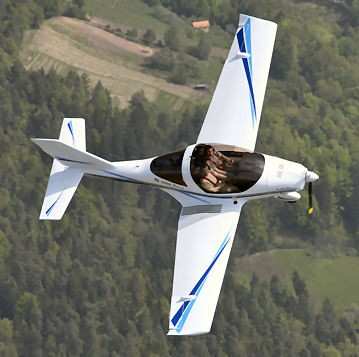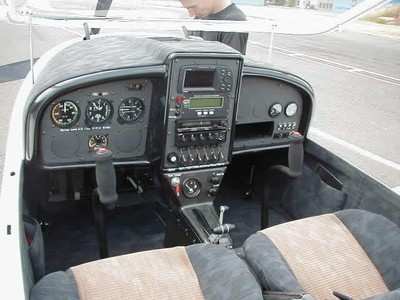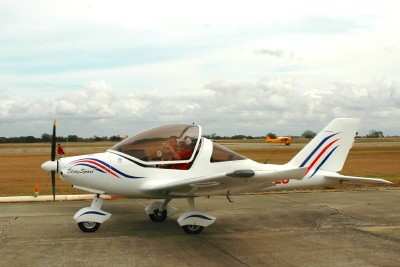Part One: TL-2000 StingSport
by ANN Managing Editor Rob Finfrock
Over the past 10 months, I've had the opportunity to spend some
seat time in three emerging players in the light sport aircraft
segment. As a Cessna 172 jockey, I must admit I wasn't expecting
much when I first took to the skies on demo flights in three
significantly smaller, lower-powered aircraft... but wow, was I
wrong.

These reports are NOT flight tests -- I'll leave the heavy
lifting around here to Jim -- but rather my impressions of these
aircraft from the perspective of a student pilot, looking at LSA as
an option to continue and expand my flight training... the same way
other potential sport pilot entrants will likely approach the
segment.
With that in mind...
SportAirUSA TL-2000 StingSport
The first LSA I had the chance to fly was the StingSport --
probably one of the best-known players in this segment. Taking a
look at the specs, you'd be hard-pressed to identify this aircraft
as an 'entry-level' plane: All-composite construction. Ballistic
parachute. Advanced avionics, including GPS-based, gyroless
instrumentation and a standard Garmin 396 with available XM
satellite radio and weather.

To my eye, the Czechoslovakian-sourced Sting also
features the most hands-down good looks, currently
unrivaled by other airplanes in the LSA market. It would not be out
of line to equate the 'Sting' to one-half of a Cirrus SR20,
for one-quarter the price.
I flew the Sting at Lakeland last spring... and immediately, I
was impressed with how "real" the plane felt. Don't get me wrong,
this is a light aircraft... to the point you have to be sure to
place your hand in just the right place during entry and exit, so
you don't inadvertently crack the less-reinforced areas of the
plane's Kevlar skin. Due to the plane's light weight and CG
location, two pilots also cannot enter the plane at the same
time; one must be seated before the other can climb onboard. These
are issues hardly limited to the Sting, though; it's simply a fact
of life when talking LSA.

Once seated, you find the beautiful construction seen on the
plane's exterior is well-matched by the interior. The padded fabric
instrument panel covering is meticulously applied; all cockpit
surfaces are either similarly padded, or constructed of smoothly
contoured composite. (I dare anyone to find one sharp edge on this
entire plane.) Control labeling is clean, in a legible font style
that is uniform throughout the panel. The seats, while
thin (another concession to weight seen throughout LSA) are quite
supportive. It's obvious the Sting is assembled with great care,
just like its larger Part 23 cousins.
As for flight characteristics, the Sting struck me as a highly
responsive aircraft. I'm no test pilot, and I can't explain the
physics of flight with phrases "static and dynamic stability and
control profiles" as others on the ANN staff can; but suffice to
say the Sting is great fun to toss around the sky, and gives a very
nimble feel through its controls. The Sting is NOT a Skyhawk.

The Sting is one of a relative handful of LSAs that advertise a
cruising speed near the 120-knot maximum, with up to 115 knots to
be expected out of the 100-hp Rotax 912ULS. To give you some idea
of the airframe's strength, Vne (Never Exceed Speed) is 164 KIAS --
a number most sport pilots should never come close to approaching.
Takeoff speed is 45 knots, with 940 feet needed on a paved runway
to clear the theoretical 50-foot obstacle at the end; landings are
done at 39 KIAS, and SportAirUSA says a lightly-loaded Sting can
come to a stop within 400 feet. Optional wing tanks bump range
(assuming no wind) to 780 nautical miles.
Something that struck me odd, coming from the C172, is the fact
the Sting did not have a stall-warning horn. I've since learned
this is common practice on several other light sport
aircraft.
Landing a Sting was also a new experience, if you're not used to
flying light planes. Simply put, this plane does NOT want to come
down. Go ahead, pull the throttle to idle as you enter downwind on
the 45; you'll probably still find you're coming in high on final.
This is certainly not an undesirable quality -- give me a plane
that would prefer to stay in the air as long as possible ANY day --
and all it would take is some training and familiarity to
adapt.

I came away with a VERY favorable impression of the
StingSport... but alas, you do pay for what you get. The very
well-equipped base-level Sting (including the GPS396, ballistic
'chute, nav lighting, and several other features that are
extra-cost options on other planes... if available at all) will run
approximately $100,000, give or take, depending on exchange rates.
Options such as autopilot, 100-hp Rotax 912UL engine (or the
certified 912 S DCDI), Dynon EFIS-10, and AmSafe seatbelt airbags
can send that price well north of $120,000.
One thing is clear... the Sting is NOT a "basic" LSA, just as a
Cadillac or Lexus is not a "basic" automobile. I suspect many
buyers will be drawn to the plane for that very fact alone.
Coming Friday... The AMD CH601 XL Zodiac
 ANN's Daily Aero-Term (04.20.24): Light Gun
ANN's Daily Aero-Term (04.20.24): Light Gun Aero-News: Quote of the Day (04.20.24)
Aero-News: Quote of the Day (04.20.24) ANN's Daily Aero-Linx (04.21.24)
ANN's Daily Aero-Linx (04.21.24) Aero-News: Quote of the Day (04.21.24)
Aero-News: Quote of the Day (04.21.24) ANN's Daily Aero-Term (04.21.24): Aircraft Conflict
ANN's Daily Aero-Term (04.21.24): Aircraft Conflict







